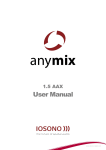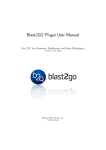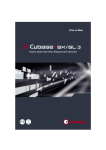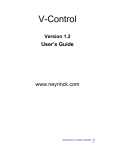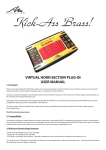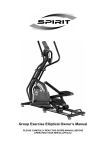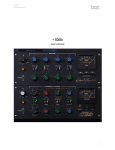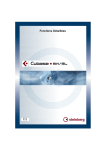Download User Manual
Transcript
User Manual The information in this document is subject to change without notice and does not represent a commitment on the part of IOSONO GmbH. Steinberg and VST are registered trademarks of Steinberg Media Technologies GmbH. Pro Tools and RTAS are registered trademarks of Avid Technology Inc. Windows, Windows Vista and Windows 7 are registered trademarks of Microsoft Corporation in the United States and other countries. Macintosh, Mac and Mac OS are trademarks of Apple Inc., registered in the U.S. and other countries. Pentium and Intel Core are trademarks or registered trademarks of Intel Corporation in the U.S. and other countries. All other product and company names are ™ and ® of their respective holders. Release Date: March 2012 © IOSONO GmbH, 2012. All rights reserved. T A B L E O F C O N T E N T S INTRODUCTION ..................................................................................................... 5 PRODUCT OVERVIEW ................................................................................................. 5 INSTALLATION ....................................................................................................... 6 ACTIVATION ............................................................................................................. 6 HOST SETUP .......................................................................................................... 7 TRACK INSERT ........................................................................................................... 7 SURROUND PANNER .................................................................................................. 8 CHANNEL ORDER....................................................................................................... 9 LATENCY COMPENSATION ......................................................................................... 10 INTERFACE AND CONTROLS................................................................................. 11 OVERVIEW ............................................................................................................. 11 Stage View............................................................................................... 12 POSITION CONTROL ................................................................................................. 13 Group Position ......................................................................................... 13 Individual Channel Adjustment ............................................................... 14 Additional Input Channel Parameters ..................................................... 15 Lock Movement ....................................................................................... 16 Distance Dependent Filters ..................................................................... 16 UPMIX .................................................................................................................. 18 What the upmix does – and what it doesn’t ........................................... 18 Upmix Interface ....................................................................................... 19 Upmix Presets .......................................................................................... 20 Input / Output Parameters ...................................................................... 21 Direct Sound Stream ............................................................................... 21 Ambient Sound Stream............................................................................ 22 ADVANCED OPTIONS ................................................................................................ 23 Distance Dependent ................................................................................ 23 Upmix ...................................................................................................... 24 LFE ........................................................................................................... 24 CONTACT & SUPPORT ....................................... ERROR! BOOKMARK NOT DEFINED. SYSTEM REQUIREMENTS ........................................................................................... 26 Windows.................................................................................................. 26 Macintosh................................................................................................ 26 IOSONO CONTACT ................................................................................................. 27 I N T R O D U C T I O N 1 Introduction The New Dimension of Surround Mixing With the IOSONO Anymix plug-in you have the power to create stunning mixes for music and film productions right at your fingertips. Thank you for choosing IOSONO, the future of spatial audio. Anymix enables you to deliver beautiful mixes with astounding complexity while providing you with a fast and easy-to-use interface. Whether it is static panning, complex motion automation or upmix processing, the Anymix plug-in does the task brilliantly. Product Overview The IOSONO Anymix plug-in is a sophisticated audio processing unit that can be either used as a substitute for any surround panner that comes with your DAW or (in any combination to that) as a powerful “upmix/fold down” processor to convert any given audio material into output formats ranging from mono to 8.1. page|5 I N S T A L L A T I O N 2 Installation Installation When successfully downloaded, simply run the Anymix installer application and follow the instructions on screen. In addition to the installation of the plugin you can choose to install the latest iLok drivers that come with the installation package. Activation To activate your copy of Anymix you need to log into your iLok account and add the Anymix license that you received via email to your iLok. If you do not already have an iLok account, here is a quick step by step guide: 1. Visit www.ilok.com, log in to your user account and go to “Redeem License Code” from the main menu. 2. Enter the activation code you received from IOSONO in the provided box and click on “Get License”. 3. Download the received license to your iLok. 4. Log out from your iLok account. Please visit www.ilok.com/ilok-faq.html for further information Remember that your iLok needs to stay connected to one of your USB ports while you use Anymix. Uninstall (Windows) The Anymix plug-in can be uninstalled from the start menu or from the “add and remove programs” dialog in the control panel. page|6 H O S T S E T U P 3 Host setup Track Insert Once installed, the Anymix plug-in can be inserted into any track by dropping it from the plug-in menu. VST hosts will list the plug-in in the “spatial + panner” subcategory. RTAS hosts will list the plug-in in the “soundfield” subcategory. For the VST version the input/output configuration of the plug-in instance can then be selected from two dropdown menus in the top left corner of the plug-in window. INPUT / OUTPUT CONFIGURATION The chosen selection is independent of the track width or audio event that currently lies within that track, but: When the Anymix plug-in is used as “insert”: The maximum input and output configuration cannot exceed the track width of the current track! Please keep in mind that the RTAS version of the plug-in cannot change the input/output configuration from within the plug-in window. To change the input/output configuration in Pro Tools a new plug-in instance is to be loaded from the plug-ins list. page|7 H O S T S E T U P Surround Panner In Steinberg Nuendo the plug-in can also be used as a stereo or surround panner by right-clicking into the panner object in the mixer window and switching from “SurroundPanner V5” to “Anymix” INSERT THE ANYMIX PLUG-IN AS (SURROUND) PANNER When the Anymix plug-in is used as “panner”: The maximum input configuration cannot exceed the track width of the current track! The maximum output configuration cannot exceed the width of the (output) bus that the track is currently routed to! If you want to use the Anymix plug-in as a (surround) panner substitute but use a different host application, simply drop it as a track insert into the last insert slot in the mixer and make sure the track width is the same as the output bus width. This lets you route the plug-in output “through” the panner object of the track into the output bus. page|8 H O S T S E T U P Channel Order The plug-in always uses the channel order of the host unless the selected output configuration differs from the current track layout. (VST hosts only) Choosing an output configuration that differs from the current track layout will result in channel oddities. If the plug-in finds a channel configuration that is not a subset of the selected output configuration (for example track = 6.1 cine, plug-in output = 7.0 music), it will route all channels along the following order: default channel order 1 2 3 4 5 6 7 8 9 L R C LFE LS RS RSS/RC LSS/LC CS Channels that are “missing” in the output configuration will then be automatically skipped. Example: track config: 6.1 Cine Plug-in output: 7.0 Music result 1 2 3 4 5 6 7 L R C LFE LS RS CS L R C LS RS LSS RSS OK 8 9 MISMATCH Please consider that unlike other hosts, Pro Tools has a very restrictive routing behavior, so that for example a track with quad output can only be routed to a 7.1 (output) bus if the corresponding sub path for that (output) bus has been created in the I/O setup panel. page|9 H O S T S E T U P Latency Compensation The Anymix plug-in causes a processing delay. The amount of latency is depending on the configured buffer size of the sound card and the used processing mode of the plug-in (panning or upmix). Most DAWs, including Steinberg Nuendo, Cubase and Avid Pro Tools, are able to compensate for this delay automatically. For Pro Tools, the delay compensation needs to be enabled manually by setting “Setup -> Playback Engine -> Delay Compensation Engine” to "Long". For all other DAWs, please refer the DAW’s manual whether you need to activate latency compensation. page|10 I N T E R F A C E 4 Interface and Controls Interface and Controls The graphical user interface is showing two main views depending on whether the upmixfeature is enabled or not. The interface of the Anymix plug-in is divided into several sections, with the “stage view” taking the most space to display the position and movement of the input channels, output configuration and distance dependent filter values. On the right side are the controls for position and movement, while the bottom section of the plug-in window contains the upmix controls. Overview 1 2 4 5 3 6 7 7 ANYMIX PRO MAIN GUI 1. 2. 3. 4. Menu Panel Input / Output Config Stage View → p.12 Position Parameters → p.13 5. 6. 7. Lock Movement → p.16 Distance Dependent Filter → p.16 Upmix Parameters → p.20 page|11 I N T E R F A C E O V E R V I E W Stage View When the Main GUI is loaded, the stage view is initialized with input channels represented by red icons and output channels indicated by gray speakers in the background of the stage. Moving the input channels outside the loudspeaker setup will result in panning between the two nearest output speakers. The input channels that are placed at smaller distances will be spread between several output speakers. STAGE VIEW If the Upmix feature is enabled, the stage is switched to a different view. → Upmix Interface, p.19 The display of the channel icon labels can be switched between channel parameters → p.15 and distance dependent values → p.16 with a dropdown menu next to the input / output configuration. CHANNEL PARAMETER DISPLAY page|12 I N T E R F A C E P O S I T I O N C O N T R O L Position Control Group Position The position of the input group can be changed by clicking and dragging anywhere into the stage view or (to create position jumps) by right-clicking anywhere into the stage. The input group is automatically shrunk when moved to the edge of the stage. This lets you easily create the illusion of depth when moving stereo or multichannel material In addition to the movement on stage, the group can also be modified with the knobs on the top right of the plug-in window POSITION CONTROL Radius/ Angle control the position of the input group center point X / Y additional control over the position of the center point Depth scale the input group in y-direction Width scale the input group in x-direction Rotation rotate the input group around its center point page|13 I N T E R F A C E P O S I T I O N C O N T R O L Notice that all input fields and knobs react to the host’s key combination for “fine adjustment”. Individual Channel Adjustment While the main position parameters always act onto the center of the input group, individual positions of each input channel can be set by double clicking the corresponding input icon in the stage view Your 5.0 ambience recording is great, but one of the microphones had the wrong angle and is too quiet? Simply adjust the parameters for that (or all) channels separately. INPUT “R” SELECTED The selected channel can then be placed on stage independently from the other input channels. To exit the individual position mode simply click anywhere on the stage view or onto the “X” in the top right corner of the “input channel” submenu. page|14 I N T E R F A C E P O S I T I O N C O N T R O L Please note that the additional input channel parameters cannot be automated from the host application but the adjustments you make for each input channel will be saved for each plug-in instance in the session. Additional Input Channel Parameters While a single input channel is selected, a submenu is displayed with additional Parameters that can be freely configured for each input channel. INDIVIDUAL INPUT CHANNEL PARAMETERS Radius/ Angle control the position of the input channel X / Y additional control over the position of the input channel Volume apply gain to the input channel LFE Volume control the amount of LFE for the selected input channel Spread distribute the audio from the selected input channel to more than two output channels 0% → audio source is rendered where the channel icon is placed 100% → audio is evenly distributed to all speakers of the output configuration Manual Delay a delay is calculated onto the selected input channel Link Parameter link a parameter with all same parameters in the current plug-in instance → change one changes all which are linked page|15 I N T E R F A C E P O S I T I O N C O N T R O L Lock Movement The movability of the input group can be locked onto either orthogonal or diagonal direction for easy automation. The movement can be locked with four buttons in the top right corner of the stage. MOVABILITY LOCK BUTTONS In most cases objects move on very simple routes around the audience. Simply lock the movability in the desired direction and create accurate movement in no time. Distance Dependent Filters To create immersive mixes even faster, the Anymix plug-in is equipped with a distance dependent filter unit that lets you adjust the volume (Loudness) and air damping (EQ) of (moving) objects automatically. Volume (Loudness) further away objects become lower in volume Air Damping (EQ) further away objects become damped in high frequencies DISTANCE DEPENDENT FILTER PARAMETERS To activate the distance dependent filtering simply choose the desired attenuation curve of the desired filter from the dropdown menu. page|16 I N T E R F A C E P O S I T I O N C O N T R O L Off deactivate distance dependent filtering Linear filtering starts right from the center point and is applied linearly good if even tiny movements should have an impact on the distance dependent filter Sinusoidal filtering starts to kick in approx. at loudspeaker distance and gets exponentially stronger with distance good if movements in the center circle should have no audible impact on the distance dependent filter Elliptical filtering starts approx. at 2/3rd of the stage with exponential attenuation curve good if only movements around the edge of the stage should have an impact on the distance dependent filter The current values can be shown with the dropdown menu above the stage view. To best suit your needs, the distance dependent filters can be further adjusted in the “Advanced” options menu. → p. 23 page|17 I N T E R F A C E U P M I X Upmix The Upmix feature is the core technology of the Anymix plug-in. IOSONO Anymix uses a highly advanced algorithm to analyze and rearrange audio material and combines it with a flexible yet easy to use graphical user interface. What the upmix does – and what it doesn’t Ever since mixing and postproduction engineers started to work for multichannel surround productions the requirement to convert or redistribute mono and stereo audio material to multichannel formats emerged quickly. The simplest way to do this is to use the DAW’s built in surround panner. But although the surround panners of modern DAWs are capable of redistributing audio material to a certain output configuration, sometimes the provided features are insufficient for complex requirements of today’s productions. If rearranging tracks with fewer input channels into a specific surround format is not enough, the upmix feature of the Anymix plug-in comes in handy. The upmix algorithm analyzes the incoming audio signal and separates it into parts of direct sound and ambient sound. While the direct sound parts are sent to the “direct sound stream” and can be placed at the “virtual” front speaker configuration, the ambient sound parts can be modified and arranged around the virtual stage. All sound parts that you hear from the “ambient” channels were already part of the audio stream. This behavior has two major consequences that you need to keep in mind: If your audio does not already have some sort of “room information”, there cannot be audio in the ambient sound stream. For example there cannot be any ambient sound extracted from a dry narrator from a recording booth. If your incoming audio signal is a badly encoded mp3, any other lossy encoded material or other bad recording of any sort, the upmix won’t make it sound better. Compression artifacts for example can easily be misinterpreted and be redistributed to the ambient sound stream. page|18 I N T E R F A C E U P M I X Upmix Interface The upmix mode can be enabled any time by clicking the On/Off switch next to the stage. UPMIX MODE ENABLED The upmix algorithm is very sophisticated and can cause high CPU load. Therefore the “On/Off” Button is not automatable. With the upmix feature enabled, the main GUI of the Anymix plug-in changes the stage to a different view where all parameters are represented by segments of a circle. 4 21 3 STAGE VIEW WITH UPMIX ENABLED 1. Divergence and Direct Dry/Wet 2. Stage Width 3. Ambience Gain and Ambience Front/Rear 4. Ambience Delay page|19 I N T E R F A C E U P M I X Please keep in mind that the position parameters for the input group and any created automation are preserved when the upmix is enabled. The “sound cloud” created by the upmix algorithm can still be moved around the stage and remains fully automatable. The “additional input parameters” however have no influence on the upmix, but they are preserved while the upmix is enabled and reloaded when the upmix is disabled. Upmix Presets Anymix has selectable upmix presets. The preset adjusts the fully customizable upmix and advanced parameters which can then be tuned by the user. An upmix preset takes effect on the following upmix parameters: Divergence, Stage Width, Direct Dry/Wet, Ambience Gain, Ambience Front/Rear, Ambience Low Pass and Ambience Delay. In the “Advanced” dialog, the following parameters are set by the preset as well: LFE Gain, LFE Low Pass Enable, LFE Low Pass Order, LFE Low Pass Cutoff Frequency and Output Gain. Upmix presets in the category “Cinema” are designed for the use with X-curve tuned speaker systems - while all other presets are designed for listening environments with a flat speaker tuning. page|20 I N T E R F A C E U P M I X Input / Output Parameters INPUT / OUTPUT Input adjust the balance of the input signal (if input signal is stereo or higher) Upmix adjust plug-in output between original and processed audio signal Direct Sound Stream DIRECT SOUND STREAM PARAMETERS Divergence control the strength of the center signal 0% → the mono components of the direct sound stream are distributed to a strong center channel 100% → the mono components of the direct sound stream are distributed to the front left and right channels Stage Width control the position of the front channels to adjust the stereo base Dry/Wet control the amount of “ambience” that remains in the direct sound stream after the ambience extraction. page|21 I N T E R F A C E U P M I X Ambient Sound Stream AMBIENT SOUND STREAM PARAMETERS Gain apply gain to the ambient sound stream to either emphasize (high gain) or damp (low gain) the amount of room in the mix Front/Rear adjust the front/rear balance of the ambient sound stream Low Pass control the ambient sound stream with a low pass filter to prevent hissing Delay add extra delay to the ambient sound stream to create the illusion of very large rooms like a stadium or empty concert hall page|22 I N T E R F A C E A D V A N C E D Advanced Options The Advanced Options Menu can be accessed from the top left button in the main plug-in window. These options can be set for the plug-in instance (by simply adjusting the values as needed), or be saved globally (for all existing and future plug-in instances) by clicking the “store user default” button after adjustments have been made. Distance Dependent ADVANCED - DISTANCE DEPENDENT Volume (Loudness) Select whether the volume change that is to be applied is depending on the position of the center group icon or if the volume change should be calculated for each input channel source separately. Set the maximum gain reduction that is applied when the group or channel source hits the stage border EQ Gain Select whether the filtering that is to be applied is depending on the position of the center group icon or if the amount of filtering should be calculated for each input channel source separately. Set the maximum gain reduction of the filter that is applied when the group or channel source hits the stage border EQ Cutoff Set the cutoff frequency of the distance dependent EQ page|23 I N T E R F A C E A D V A N C E D Upmix ADVANCED - UPMIX Matrix Activate / Deactivate Matrix decoding for matrix encoded input signals If activated in the advanced options menu, matrix decoding is only active when the upmix feature is enabled! LFE ADVANCED – LFE OUT LFE Gain Set a separate gain level for the LFE Channel that is set at the plug-in output stage. LP Enable Enable a low pass filter that is applied to the LFE output channel after summing up the signals from the input channels. LP Order Select the order of the low pass filter: 2nd = 12 dB/octave 3rd = 18 dB/octave 4th = 24 dB/octave LP Cutoff Set the cutoff frequency for the generated LFE channel page|24 I N T E R F A C E A D V A N C E D Please keep in mind that the amount of LFE for each input channel can be adjusted in the → additional input channel parameters p. 15 If the selected input configuration includes a LFE channel, but the selected output configuration does not, the LFE input channel will be distributed to “front left” and “front right” at a level of -3 dB automatically. The low pass filter is applied to the incoming LFE signal before it is distributed to the front speakers. page|25 C O N T A C T & S U P P O R T System Requirements Windows System Requirements: OS: CPU: RAM: HDD: Windows XP (SP2) / Vista / 7 Intel Dual Core 2.0GHz 2 GB (4 GB recommended) 100 MB of free hard disk space Display Resolution: 1024 x 768 pixels (1280 x 800 pixels recommended) iLok and internet connection for license activation Supported Hosts: VST2.4 compatible host application 32 and 64 bit Avid Pro Tools 9 (or higher) Macintosh System Requirements: OS: CPU: RAM: HDD: OSX Snow Leopard (10.6.2) or higher Intel Dual Core 2.0GHz 2 GB (4 GB recommended) 100 MB of free hard disk space Display Resolution: 1024 x 768 pixels (1280 x 800 pixels recommended) iLok and internet connection for license activation Supported Hosts: Any VST2.4 compatible host application 32 and 64 bit Avid Pro Tools 9 (or higher) page|26 C O N T A C T & S U P P O R T IOSONO Contact Feel free to contact us with any problems or suggestions under: [email protected] Check our website for updates: www.iosono-sound.com page|27



























